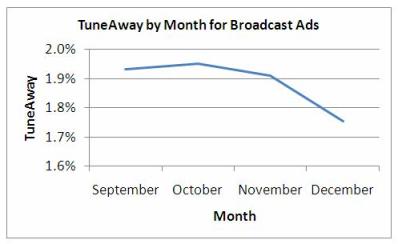Simulmedia: Introduction to the Spot TuneAway Metric - Stewart Hauser - MediaBizBloggers

Viewers have numerous ways to avoid watching ads. Some methods - changing the channel, fast-forwarding, or lowering the volume - are enabled by technology, while others - chatting, phone calls, kitchen or bathroom breaks - have been with us since the birth of television. These actions are all bad news for marketers, whose campaigns depend largely on reach. Not paying attention to ads, or bypassing them altogether, lowers reach, thereby diminishing the effectiveness of a campaign.
Not all methods of bypassing ads can easily be measured. We wouldn't be able to tell when someone is sending a text message rather than watching a commercial without using extremely invasive measurement techniques. Thanks to set-top box (STB) data, however, we can easily measure channel-changing during commercials, behavior that hurts both campaigns and the carrier channels, since there is no guarantee that viewers will return once the commercial break ends.
Kantar Media's InfoSys data product contains a "TuneAway" metric that measures loss of audience during advertisements. Specifically, TuneAway is the percentage of seconds not watched of an advertisement, compared to the number of seconds that could have been watched based on viewership one second before the ad aired. For example, if exactly one STB is watching a network, and that STB stays tuned in for the full duration of a given commercial, TuneAway for that commercial would be 0%. If a network airs a 30-second commercial and the STB tunes away after 27 seconds, TuneAway would be 10%.
The TuneAway metric has no concept of quantity or total viewership, so we cannot look at raw TuneAway numbers and make conclusions about the number of people who remained to watch the ad. Nevertheless, TuneAway is a useful metric for comparing one advertisement to another, or for aggregating to look at larger trends.
Various studies have looked at audience retention during advertisements to try to understand viewing habits and ultimately improve advertising yield. One study looked at viewing behavior during targeted advertisements versus non-targeted advertisements, and found that viewers were 32% less likely to change the channel during targeted ads than during other ads. Both channels and marketers benefit from this finding. Google TV has also done some relevant work in this area, including an analysis that looks at historical reactions to advertisements and tries to use that information to predict future audience behavior.
TuneAway data can clearly be examined in a number of different ways. For now, we can start by looking at TuneAway by month. The graph below is based on a dataset containing all television advertisements (both promos and commercials) on five leading broadcast channels from September through December 2009:

On average, TuneAway tends to be a little under 2%. Of the last four months, October had the highest TuneAway at 1.95%, while December had the lowest with 1.75%. Individual advertisements can have TuneAway rates of 10% or higher, but on average the values tend to hover around 2%.
Lower TuneAway in December could be attributed to a number of factors. Perhaps viewers had holiday shopping on their minds and decided to pay more attention to commercials. Advertisements also might have been more interesting or better targeted in December compared to other months. The subject requires further analysis.
Forthcoming blog entries will analyze TuneAway from a number of other angles. One interesting problem to address is TuneAway by spot position in pod, and whether high TuneAway numbers are always undesirable.
Data from Kantar Media's InfoSys product using DIRECTV data.
Stewart can be reached at stewart@simulmedia.com.
Read all Stewart's MediaBizBloggers commentaries at Simulmedia - MediaBizBloggers.
Follow our Twitter updates @MediaBizBlogger


